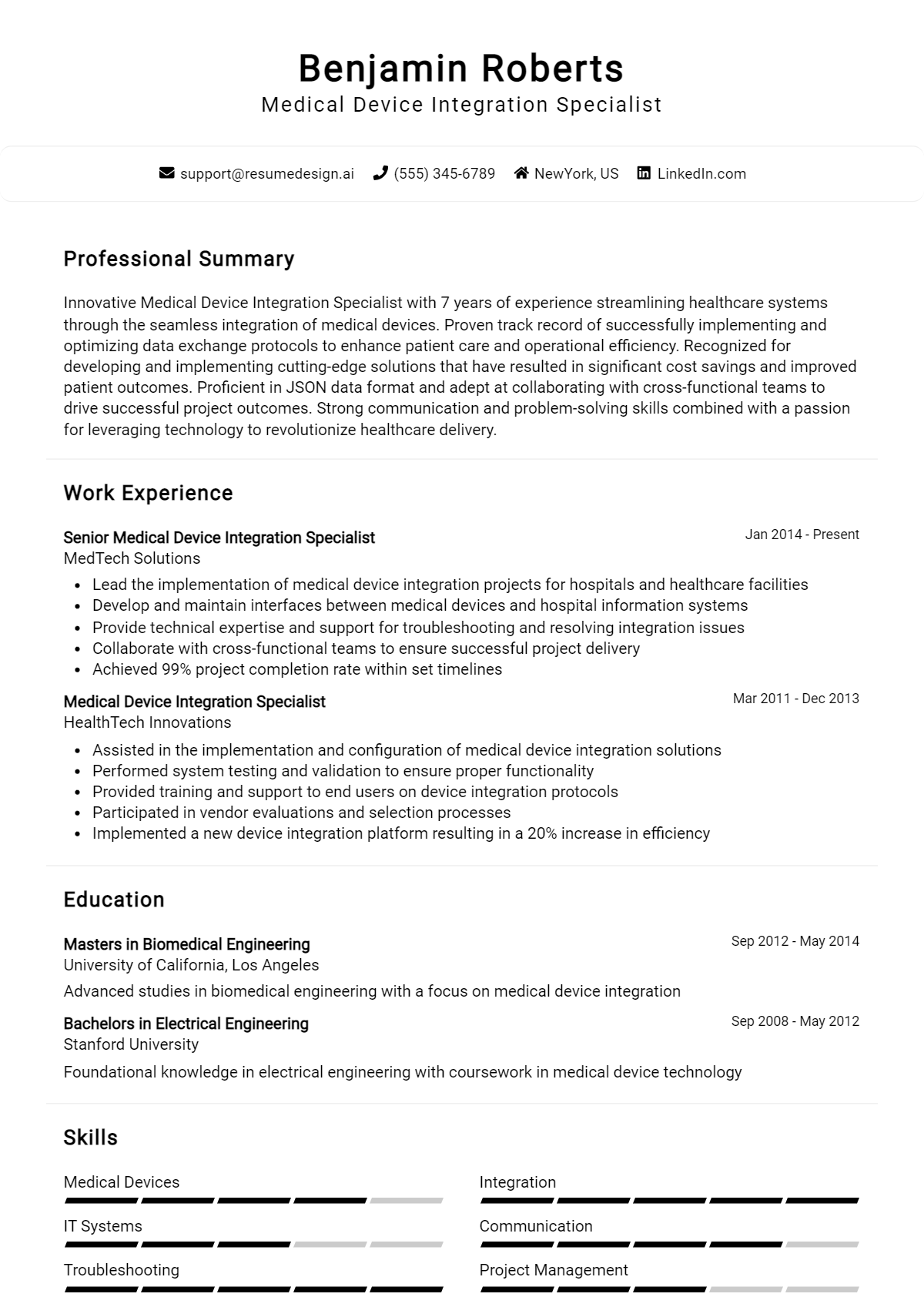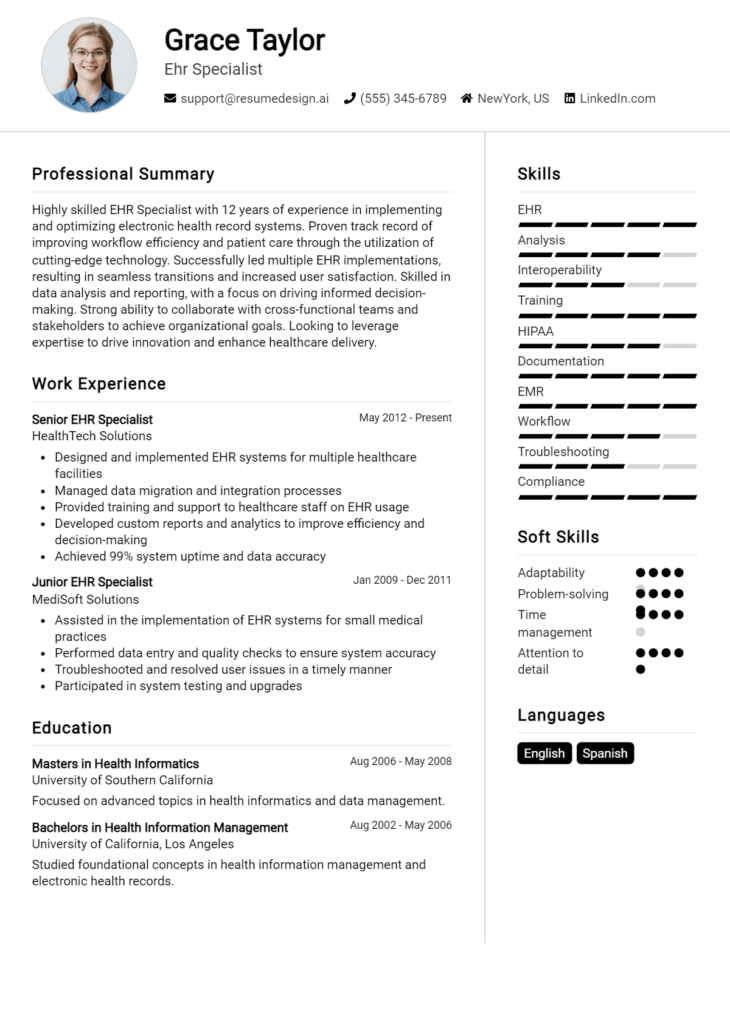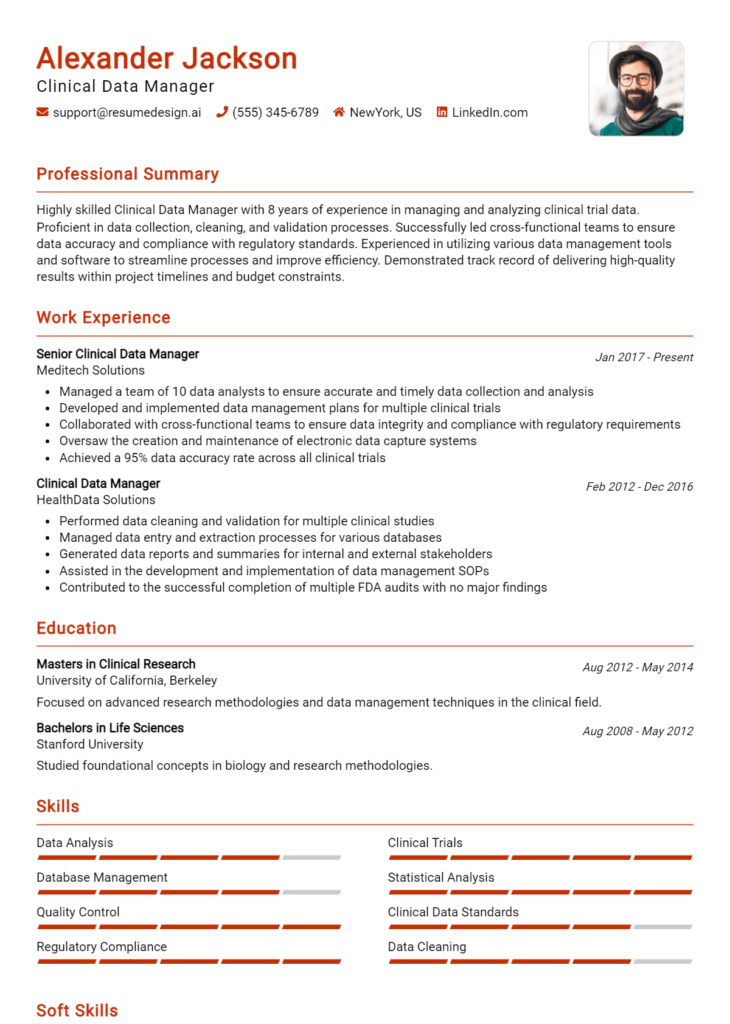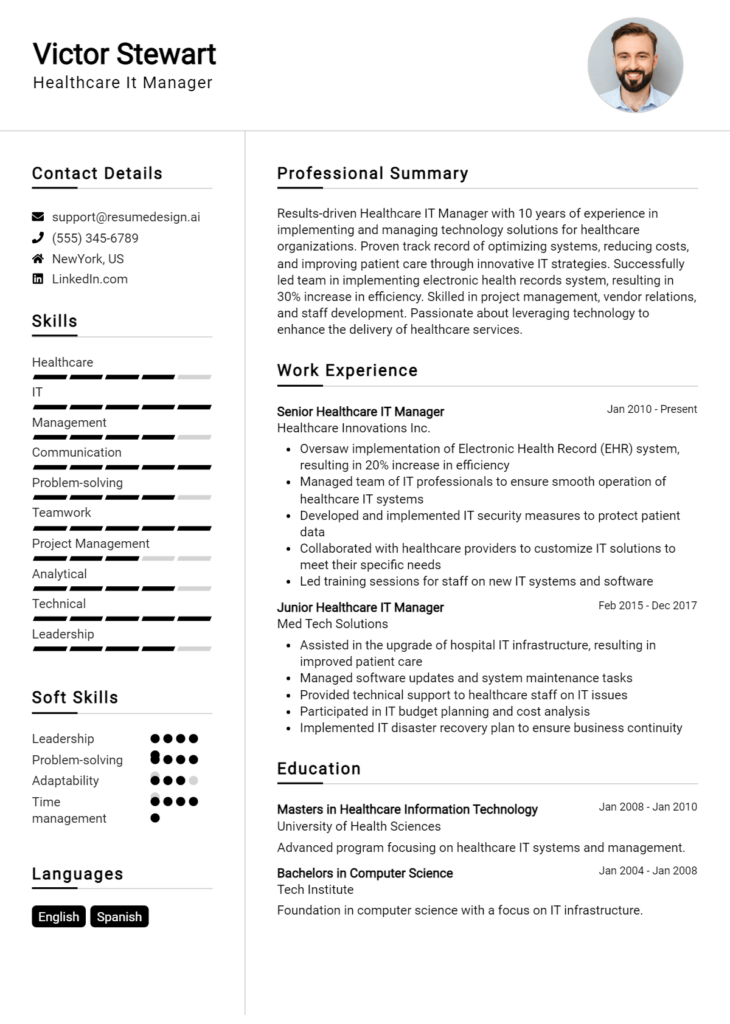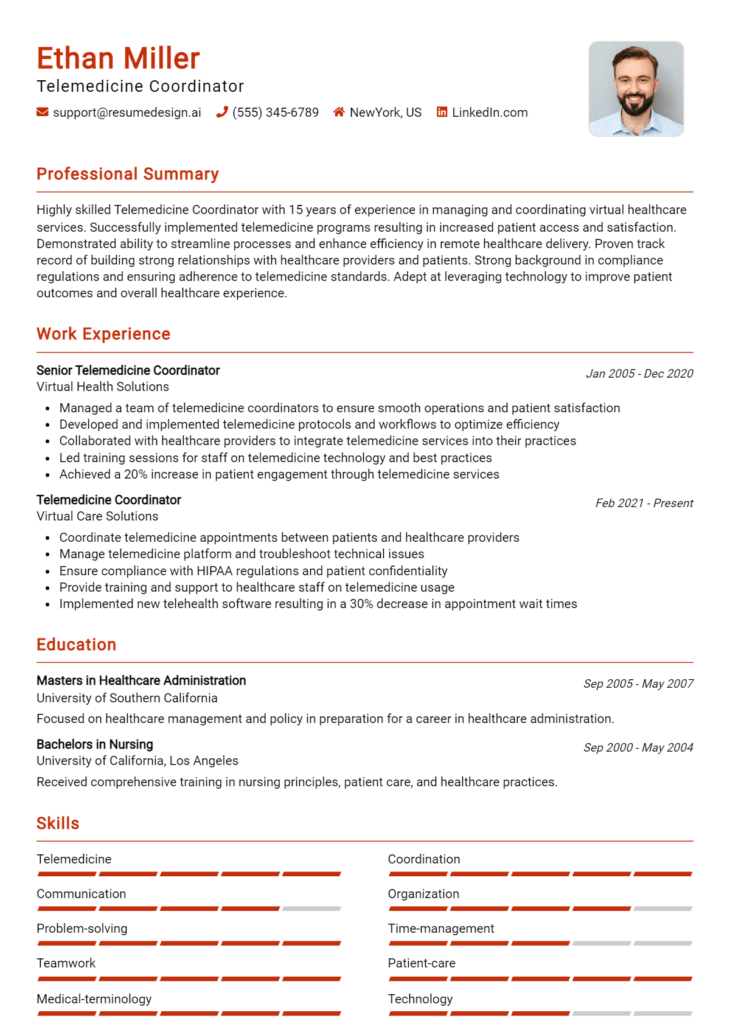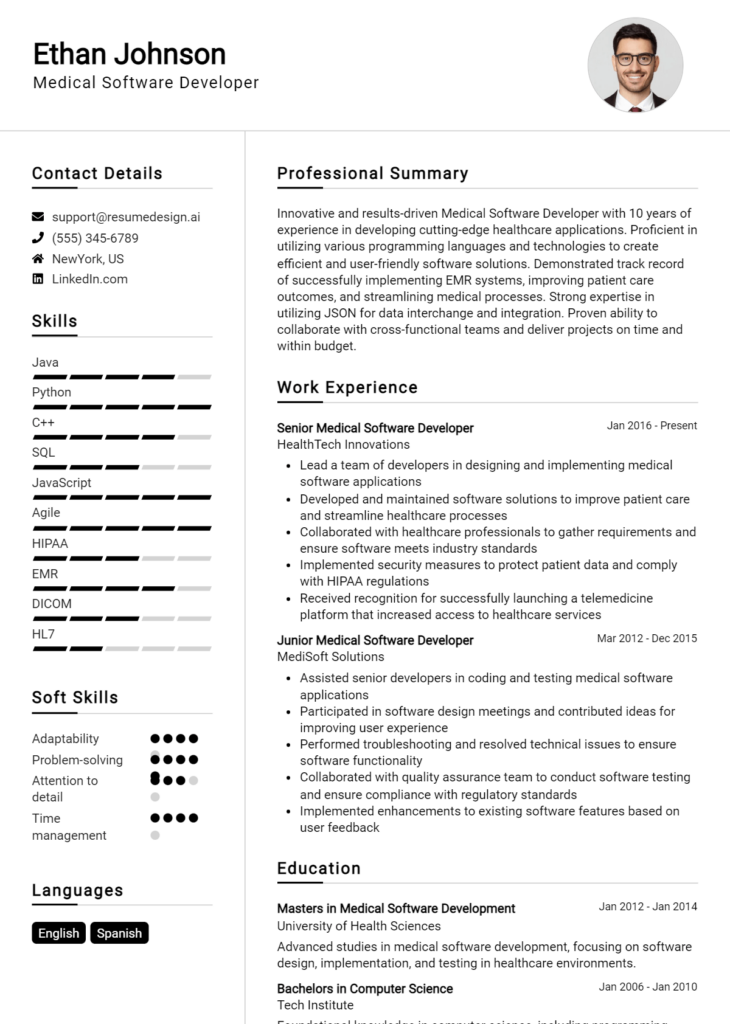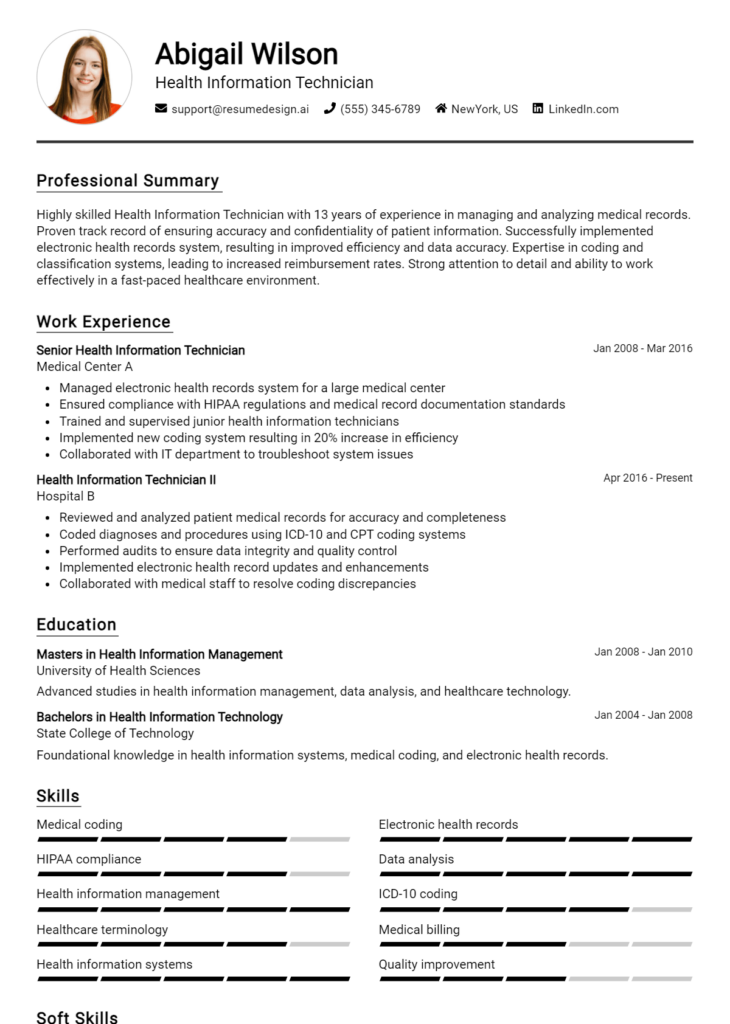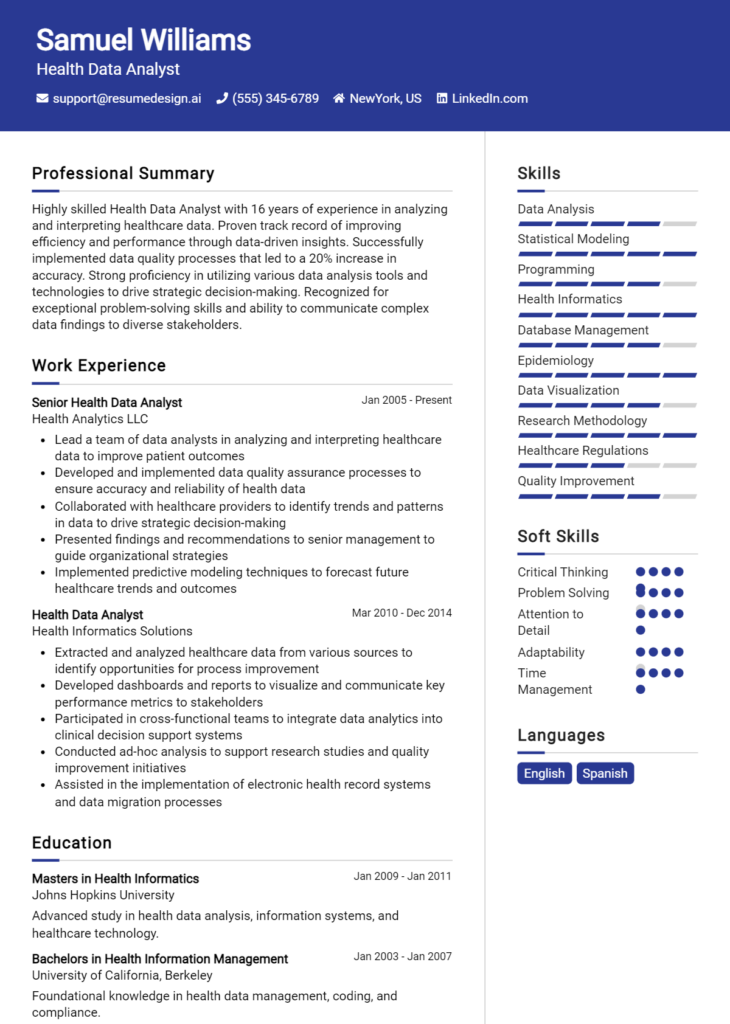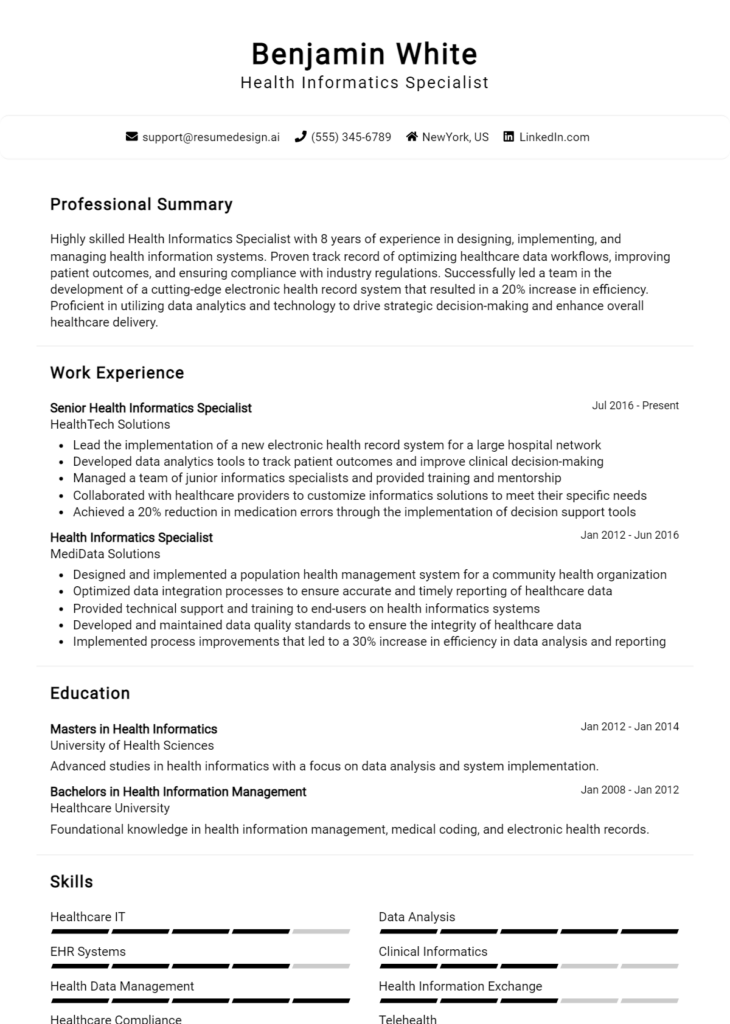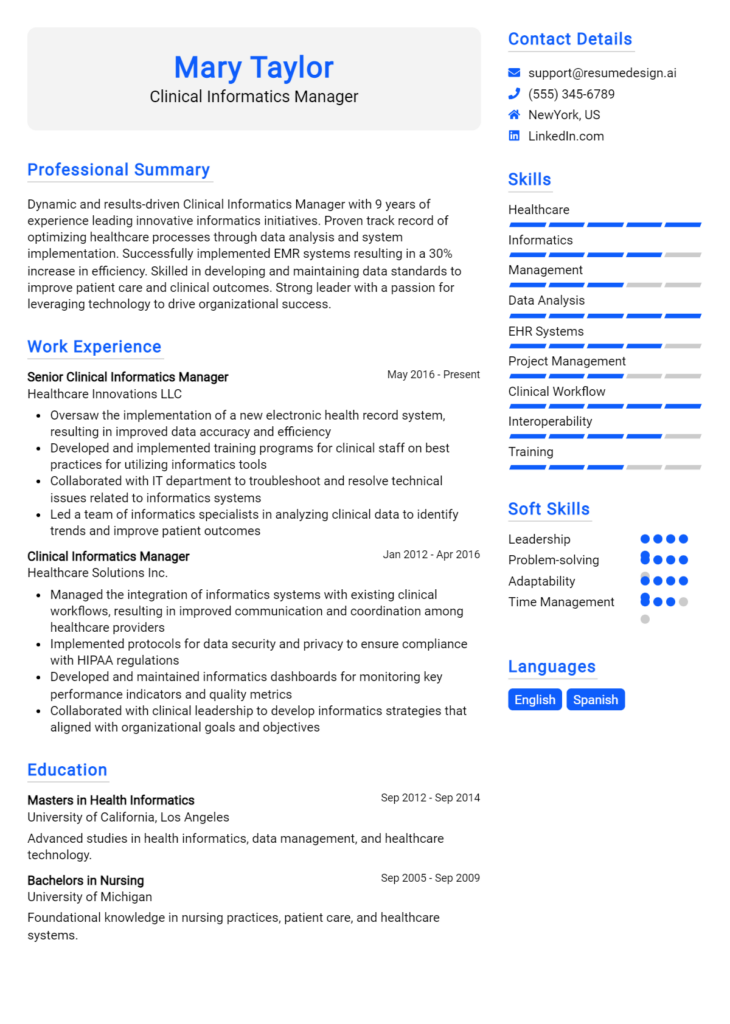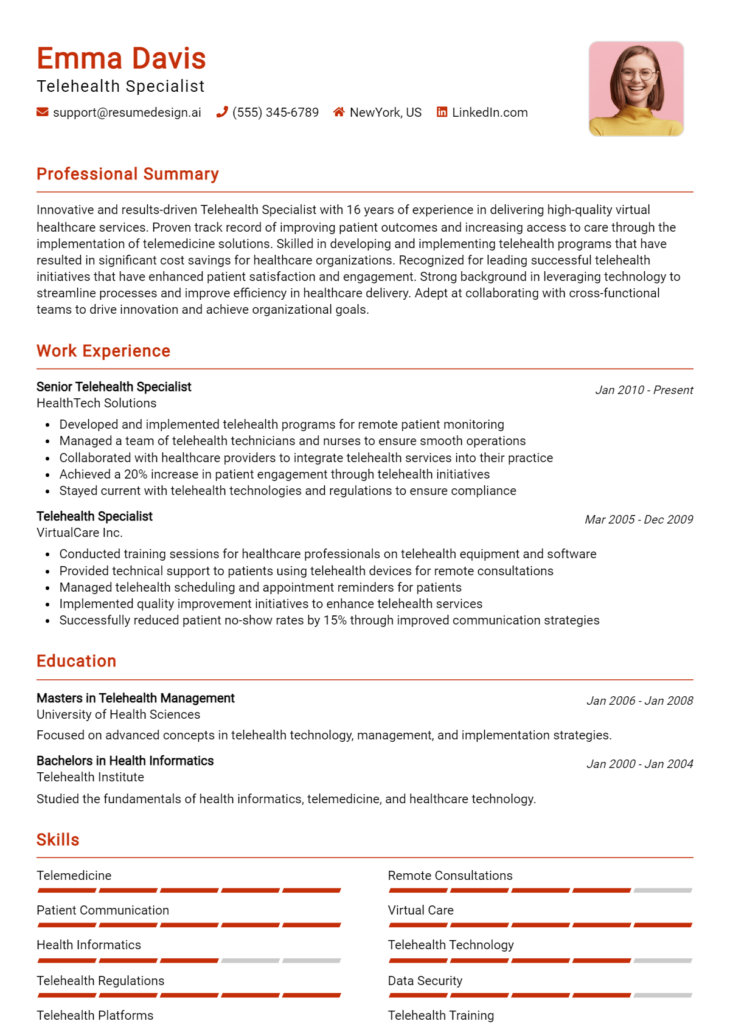Medical Device Integration Specialist Core Responsibilities
A Medical Device Integration Specialist plays a crucial role in enhancing healthcare delivery by bridging technology and clinical operations. This professional is responsible for integrating medical devices with healthcare systems, ensuring seamless data flow, and optimizing functionality. Key skills include technical proficiency, operational insight, and strong problem-solving abilities, which are essential for troubleshooting and maintaining device interoperability. These competencies contribute significantly to the organization's objectives by improving patient outcomes and operational efficiency. A well-structured resume can effectively showcase these qualifications, highlighting relevant experiences and technical expertise.
Common Responsibilities Listed on Medical Device Integration Specialist Resume
- Develop and implement integration strategies for medical devices.
- Collaborate with IT, clinical teams, and vendors to ensure seamless device functionality.
- Conduct system testing and validation of integrated devices.
- Troubleshoot and resolve technical issues related to device integration.
- Maintain documentation of device configurations and integration processes.
- Provide training and support to healthcare staff on device usage.
- Monitor and analyze data flow between devices and systems.
- Stay updated with industry standards and regulatory requirements.
- Participate in project management activities for device integration initiatives.
- Conduct risk assessments related to device interoperability.
High-Level Resume Tips for Medical Device Integration Specialist Professionals
In the competitive field of medical device integration, a well-crafted resume is crucial for standing out among other candidates. As the first impression potential employers have of you, your resume needs to effectively showcase your unique skills and achievements relevant to the role. It should not just be a list of past jobs but a compelling narrative that reflects your expertise in integrating medical technology and your understanding of healthcare environments. In this guide, we will provide practical and actionable resume tips specifically tailored for Medical Device Integration Specialist professionals to help you construct a resume that resonates with hiring managers.
Top Resume Tips for Medical Device Integration Specialist Professionals
- Tailor your resume to the job description by emphasizing the skills and experiences that align with the specific requirements of the position.
- Highlight relevant experience in medical device integration projects, including specifics about the technologies and methodologies used.
- Quantify your achievements by using metrics (e.g., improved integration efficiency by 30% or reduced downtime by 15%) to demonstrate your impact.
- Incorporate industry-specific keywords from the job posting to help your resume pass through Applicant Tracking Systems (ATS).
- Showcase certifications and training relevant to medical device integration, such as those from regulatory bodies or industry organizations.
- Include a summary statement at the top of your resume that encapsulates your expertise and career objectives in medical device integration.
- List technical skills prominently, such as knowledge of interoperability standards, data security, and regulatory compliance.
- Demonstrate your problem-solving abilities by detailing specific challenges you faced in past roles and how you overcame them.
- Keep the format clean and professional, using clear headings and bullet points to enhance readability.
- Proofread for errors and ensure that all information is accurate and up-to-date to portray professionalism.
By implementing these tips, you can significantly increase your chances of landing a job in the Medical Device Integration Specialist field. A strong resume not only showcases your qualifications but also communicates your dedication to the industry and your readiness to contribute effectively to potential employers. Remember, your resume is your personal marketing tool—make it count!
Why Resume Headlines & Titles are Important for Medical Device Integration Specialist
In the competitive field of medical device integration, a well-crafted resume headline or title is crucial for standing out to hiring managers. This succinct phrase serves as the first impression of a candidate's qualifications, immediately capturing attention and summarizing key competencies. A strong headline not only reflects the applicant's expertise but also aligns with the specific requirements of the Medical Device Integration Specialist role. By being concise, relevant, and directly connected to the job in question, an impactful headline can set the tone for the rest of the resume, encouraging further exploration of the applicant's credentials.
Best Practices for Crafting Resume Headlines for Medical Device Integration Specialist
- Keep it concise—aim for one powerful phrase that encapsulates your expertise.
- Make it role-specific—ensure the headline addresses the Medical Device Integration Specialist position directly.
- Highlight key skills—include essential skills or certifications relevant to the role.
- Use action-oriented language—employ strong verbs to convey your impact and contributions.
- Incorporate industry keywords—utilize terminology that reflects your understanding of the medical device field.
- Avoid jargon—keep the language clear and accessible to a wide audience, including non-specialists.
- Reflect your experience level—consider including years of experience or notable achievements.
- Tailor for each application—customize your headline for different job applications to highlight the most relevant qualifications.
Example Resume Headlines for Medical Device Integration Specialist
Strong Resume Headlines
"Innovative Medical Device Integration Specialist with 5+ Years in Healthcare Technology"
“Results-Driven Expert in Medical Device Systems Integration and Compliance Management”
“Certified Medical Device Integration Specialist Specializing in IoT Solutions for Patient Monitoring”
“Dynamic Professional with Proven Track Record in Streamlining Medical Device Workflows”
Weak Resume Headlines
“Looking for a Job in Healthcare”
“Experienced Professional”
The strong headlines are effective because they are specific, highlight relevant skills, and clearly articulate the candidate's unique qualifications in the context of the Medical Device Integration Specialist role. They offer a glimpse into the applicant's experience and achievements while employing industry-specific terminology that resonates with hiring managers. In contrast, the weak headlines fail to provide any meaningful insight into the candidate's qualifications, relying on vague descriptions that do not communicate value or relevance to the position, making them easily forgettable.
Writing an Exceptional Medical Device Integration Specialist Resume Summary
A well-crafted resume summary is crucial for a Medical Device Integration Specialist as it serves as the first impression for hiring managers. A strong summary quickly captures attention by effectively showcasing key skills, relevant experience, and notable accomplishments that align with the job requirements. In a competitive field where technical expertise and understanding of medical regulations are paramount, a concise and impactful summary tailored to the specific role can significantly enhance a candidate's chances of standing out among other applicants.
Best Practices for Writing a Medical Device Integration Specialist Resume Summary
- Quantify Achievements: Use specific numbers or outcomes to demonstrate your impact in previous roles.
- Focus on Relevant Skills: Highlight the technical and soft skills that are most applicable to the Medical Device Integration Specialist role.
- Tailor to the Job Description: Customize your summary to reflect the key requirements and responsibilities of the position you are applying for.
- Be Concise: Keep your summary to 2-4 sentences to maintain clarity and impact.
- Use Action Verbs: Start sentences with strong action verbs to convey a sense of proactivity and effectiveness.
- Highlight Certifications: Mention any relevant certifications or training that enhance your qualifications for the role.
- Showcase Problem-Solving Skills: Include examples of how you've successfully addressed challenges in previous positions.
- Maintain Professional Tone: Use a professional and confident tone that reflects your expertise in the field.
Example Medical Device Integration Specialist Resume Summaries
Strong Resume Summaries
Results-driven Medical Device Integration Specialist with over 5 years of experience in streamlining device interoperability, leading to a 30% increase in operational efficiency. Skilled in regulatory compliance and project management, certified in ISO 13485 and FDA regulations.
Detail-oriented professional with extensive experience integrating complex medical devices into hospital systems. Successfully reduced integration time by 20% through effective stakeholder communication and innovative problem-solving strategies.
Dynamic Medical Device Integration Specialist with a proven track record of enhancing device functionality, resulting in a 40% reduction in downtime. Proficient in data analysis and technical troubleshooting, with a solid background in software development.
Weak Resume Summaries
Experienced in medical devices and integration tasks, looking for a new opportunity in the healthcare field.
Skilled professional with some experience in medical device integration and related areas. Eager to contribute to a team.
The strong resume summaries are considered effective because they provide specific, quantifiable achievements and clearly showcase relevant skills aligned with the Medical Device Integration Specialist role. In contrast, the weak summaries lack detail and specificity, making them generic and less impactful, which fails to capture the interest of hiring managers.
Work Experience Section for Medical Device Integration Specialist Resume
The work experience section of a Medical Device Integration Specialist resume is critical as it provides a comprehensive overview of the candidate's professional background, showcasing their technical skills, team management capabilities, and ability to deliver high-quality products in the medical device field. This section allows candidates to demonstrate their expertise in integrating complex medical technologies, ensuring compliance with industry standards, and achieving measurable results. By quantifying achievements and aligning experiences with industry benchmarks, candidates can effectively illustrate their value to potential employers, making a compelling case for their suitability for the role.
Best Practices for Medical Device Integration Specialist Work Experience
- Highlight specific technical skills relevant to medical device integration, such as software development, system architecture, or regulatory compliance.
- Quantify achievements with clear metrics, such as reduced integration time, cost savings, or improved patient outcomes.
- Emphasize collaboration by detailing experiences working with cross-functional teams, including engineers, healthcare professionals, and management.
- Use action verbs to convey impact and responsibility clearly, such as "led," "developed," "implemented," and "optimized."
- Align experiences with industry standards and practices, demonstrating familiarity with relevant regulations and guidelines.
- Include certifications or specialized training that enhances your qualifications in the medical device sector.
- Showcase problem-solving skills by providing examples of challenges faced and solutions implemented.
- Keep descriptions concise yet informative, ensuring clarity and focus on what matters most to potential employers.
Example Work Experiences for Medical Device Integration Specialist
Strong Experiences
- Led a cross-functional team to integrate a new cardiac monitoring system, resulting in a 30% reduction in patient transfer time and a 15% increase in data accuracy.
- Developed and implemented a compliance framework for medical device software, achieving 100% adherence to FDA regulations during audits.
- Collaborated with engineering and clinical staff to design an interoperability solution that improved data sharing between devices, enhancing patient care and reducing redundancy by 25%.
- Optimized the integration process for a multi-device system, decreasing installation time by 40% and increasing user satisfaction ratings by 20%.
Weak Experiences
- Worked on various medical device projects.
- Assisted in integrating some systems.
- Participated in team meetings to discuss device integration.
- Helped with troubleshooting issues as they arose.
The examples labeled as strong are characterized by specific, quantifiable results that demonstrate the candidate's impact and technical leadership in medical device integration. They showcase the ability to collaborate effectively and achieve measurable improvements in processes and outcomes. Conversely, the weak experiences lack detail and specificity, failing to convey the candidate's contributions or the significance of their roles, which diminishes their overall impact on the resume.
Education and Certifications Section for Medical Device Integration Specialist Resume
The education and certifications section of a Medical Device Integration Specialist resume plays a crucial role in establishing the candidate's qualifications and expertise in the field. This section not only showcases the candidate's academic background, including relevant degrees and coursework, but it also highlights industry-recognized certifications and continuous learning efforts that reflect their commitment to professional development. By providing details on specialized training and certifications, candidates can enhance their credibility and demonstrate their alignment with the technical and regulatory demands of the role, making them more attractive to potential employers.
Best Practices for Medical Device Integration Specialist Education and Certifications
- Focus on relevant degrees, such as Biomedical Engineering, Healthcare Informatics, or Computer Science.
- Include industry-recognized certifications, such as Certified Biomedical Equipment Technician (CBET) or Certified Health Informatics Systems Professional (CHISP).
- Highlight specialized training programs that pertain to medical device integration or interoperability standards.
- Provide specific coursework that aligns with the skills required for the position, such as courses in systems integration, data management, or regulatory compliance.
- Keep the section concise and focused, avoiding outdated certifications or irrelevant qualifications.
- Use clear formatting to ensure easy readability, such as bullet points for each qualification.
- Update this section regularly to reflect any new certifications or educational achievements.
- Consider including continuing education credits or workshops attended that are relevant to the field.
Example Education and Certifications for Medical Device Integration Specialist
Strong Examples
- Bachelor of Science in Biomedical Engineering, University of XYZ, 2020
- Certified Health Informatics Systems Professional (CHISP), 2021
- Coursework in Medical Device Software Development, University of ABC
- Certification in Health Information Technology from the National Institute of Health, 2022
Weak Examples
- Bachelor of Arts in History, University of DEF, 2018
- Certification in Personal Training, 2020
- High School Diploma, Graduated 2015
- Outdated certification in Windows Operating Systems, 2015
The strong examples are considered relevant because they directly relate to the skills and knowledge necessary for a Medical Device Integration Specialist, showcasing a focused educational background and certifications that enhance the candidate's qualifications. In contrast, the weak examples lack relevance to the medical device field and do not demonstrate the specialized knowledge or skills required for the role, which can undermine the candidate's credibility and potential fit for the position.
Top Skills & Keywords for Medical Device Integration Specialist Resume
In the rapidly evolving field of medical technology, the role of a Medical Device Integration Specialist is crucial for ensuring that various devices and systems work seamlessly together. A well-crafted resume that highlights both hard and soft skills is essential for standing out in this competitive job market. Employers look for candidates who not only possess technical expertise but also demonstrate strong interpersonal abilities, as collaboration with healthcare professionals and technical teams is a fundamental part of the job. By effectively showcasing these skills, candidates can convey their capability to enhance patient care through the integration of medical devices.
Top Hard & Soft Skills for Medical Device Integration Specialist
Soft Skills
- Communication Skills
- Problem-Solving Abilities
- Attention to Detail
- Teamwork and Collaboration
- Adaptability and Flexibility
- Critical Thinking
- Time Management
- Empathy and Patient Focus
- Project Management
- Leadership Skills
Hard Skills
- Knowledge of Medical Device Regulations (FDA, ISO)
- Proficiency in Medical Device Software Integration
- Familiarity with Electronic Health Records (EHR)
- Experience with Network Security Protocols
- Understanding of Data Interoperability Standards (HL7, FHIR)
- Technical Troubleshooting Skills
- Familiarity with Medical Imaging Systems
- Programming Skills (Python, Java, etc.)
- Knowledge of Clinical Workflow Processes
- Experience with System Testing and Validation
For a comprehensive guide on how to effectively highlight your skills and showcase your work experience in your resume, consider incorporating these essential elements.
Stand Out with a Winning Medical Device Integration Specialist Cover Letter
Dear Hiring Manager,
I am writing to express my interest in the Medical Device Integration Specialist position at [Company Name], as advertised on [where you found the job listing]. With a solid background in biomedical engineering and extensive experience in integrating medical devices within healthcare systems, I am excited about the opportunity to contribute to your team and support the seamless integration of innovative technologies that enhance patient care.
In my previous role at [Previous Company Name], I successfully led a project to integrate a suite of telemetry devices with existing hospital information systems. This initiative not only improved data accuracy and accessibility for clinical staff but also significantly reduced response times during critical patient care situations. My technical skills, coupled with a strong understanding of compliance regulations such as HIPAA and FDA standards, allow me to navigate the complexities of medical device integration while ensuring that patient safety and data integrity remain top priorities.
I am particularly impressed with [Company Name]’s commitment to advancing healthcare technology and its focus on improving patient outcomes. I am eager to bring my skills in project management, cross-functional collaboration, and troubleshooting to your team. I am confident that my proactive approach to problem-solving and my dedication to continuous learning will enable me to thrive in this dynamic role.
Thank you for considering my application. I look forward to the opportunity to discuss how my experience and passion for medical device integration can contribute to the innovative projects at [Company Name]. I am excited about the possibility of working together to enhance healthcare delivery through cutting-edge technology.
Sincerely,
[Your Name]
[Your Contact Information]
[Your LinkedIn Profile]
Common Mistakes to Avoid in a Medical Device Integration Specialist Resume
When crafting a resume for the position of a Medical Device Integration Specialist, it's crucial to avoid common pitfalls that can hinder your chances of securing an interview. A well-structured resume should effectively highlight your skills, experience, and achievements while demonstrating your knowledge of medical devices and integration processes. However, many candidates make mistakes that can detract from their qualifications. Here are some common mistakes to avoid:
Generic Objective Statements: Using a one-size-fits-all objective can come off as impersonal. Tailor your objective to reflect your specific interest in the role and the organization.
Neglecting Technical Skills: Failing to clearly list relevant technical skills can be detrimental. Ensure you highlight proficiency in software, hardware, and integration processes specific to medical devices.
Overloading with Jargon: While technical terms are essential, overloading your resume with jargon can confuse hiring managers. Strive for balance by using accessible language where appropriate.
Lack of Quantifiable Achievements: Avoid vague statements about your experience. Include measurable achievements, such as “improved device integration efficiency by 25%,” to demonstrate your impact.
Ignoring Industry Standards: Not mentioning familiarity with industry regulations, such as FDA guidelines or ISO standards, can signal a lack of relevant knowledge. Highlight your understanding of compliance and safety standards.
Poor Formatting: A cluttered or unprofessional layout can make your resume hard to read. Use clear headings, bullet points, and consistent font styles to enhance readability.
Excessive Length: A resume that is too long can overwhelm recruiters. Aim for a concise presentation of your qualifications, ideally one page for early-career professionals and no more than two for experienced candidates.
Skipping Customization: Submitting the same resume for multiple applications can result in missed opportunities. Customize your resume for each job by aligning your skills and experiences with the job description.
Conclusion
As a Medical Device Integration Specialist, you play a crucial role in ensuring that medical devices work seamlessly within healthcare systems. This position demands a blend of technical expertise, problem-solving skills, and an understanding of healthcare protocols. Key responsibilities often include integrating new devices with existing hospital systems, troubleshooting issues, and collaborating with both clinical and technical teams to enhance patient care.
Given the complexity of this role, it’s essential to present your qualifications effectively in your resume. Highlight your technical skills, relevant experience, and any certifications that enhance your credibility in the field. Tailoring your resume to showcase your problem-solving abilities and experience with specific technologies can significantly increase your chances of landing an interview.
Now is the perfect time to review and update your Medical Device Integration Specialist resume. Take advantage of the resources available to you, including resume templates, which can help you structure your information clearly and professionally. Utilize the resume builder to create a polished document that stands out to potential employers. Additionally, explore resume examples to gather inspiration and see how other professionals in your field present their skills and experiences. Don’t forget the importance of a well-crafted introduction; check out the cover letter templates to complement your resume and make a strong first impression.
Take action today—revise your resume and leverage these tools to effectively showcase your expertise as a Medical Device Integration Specialist. Your next opportunity is just a well-prepared application away!

